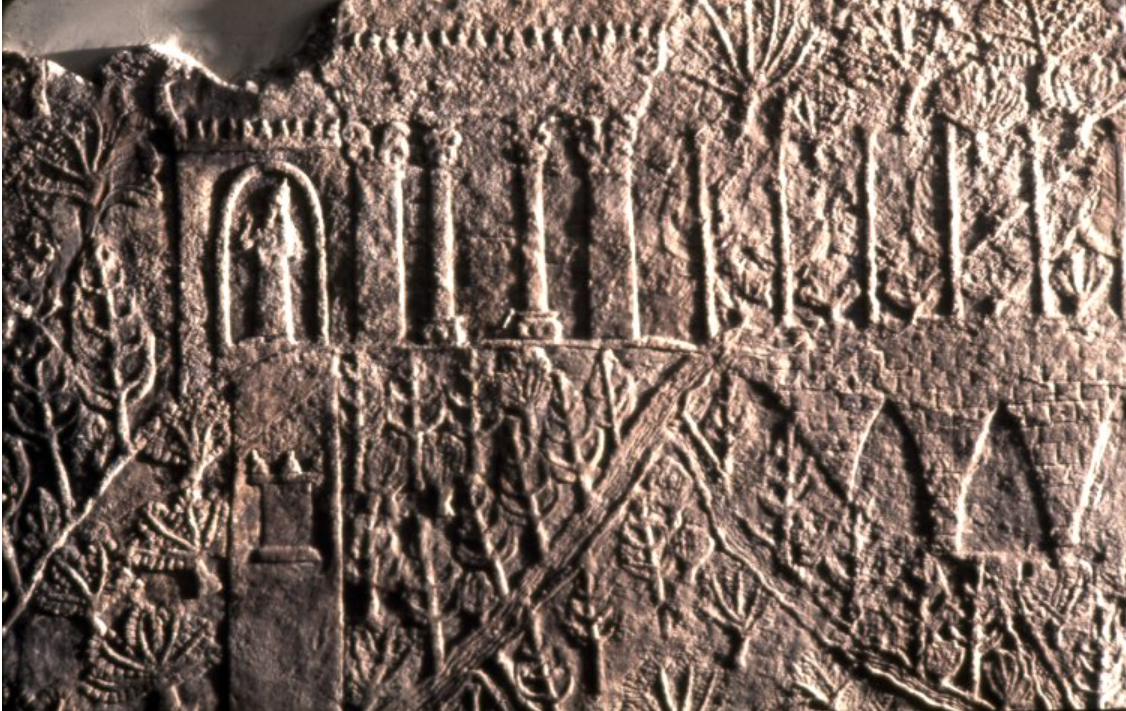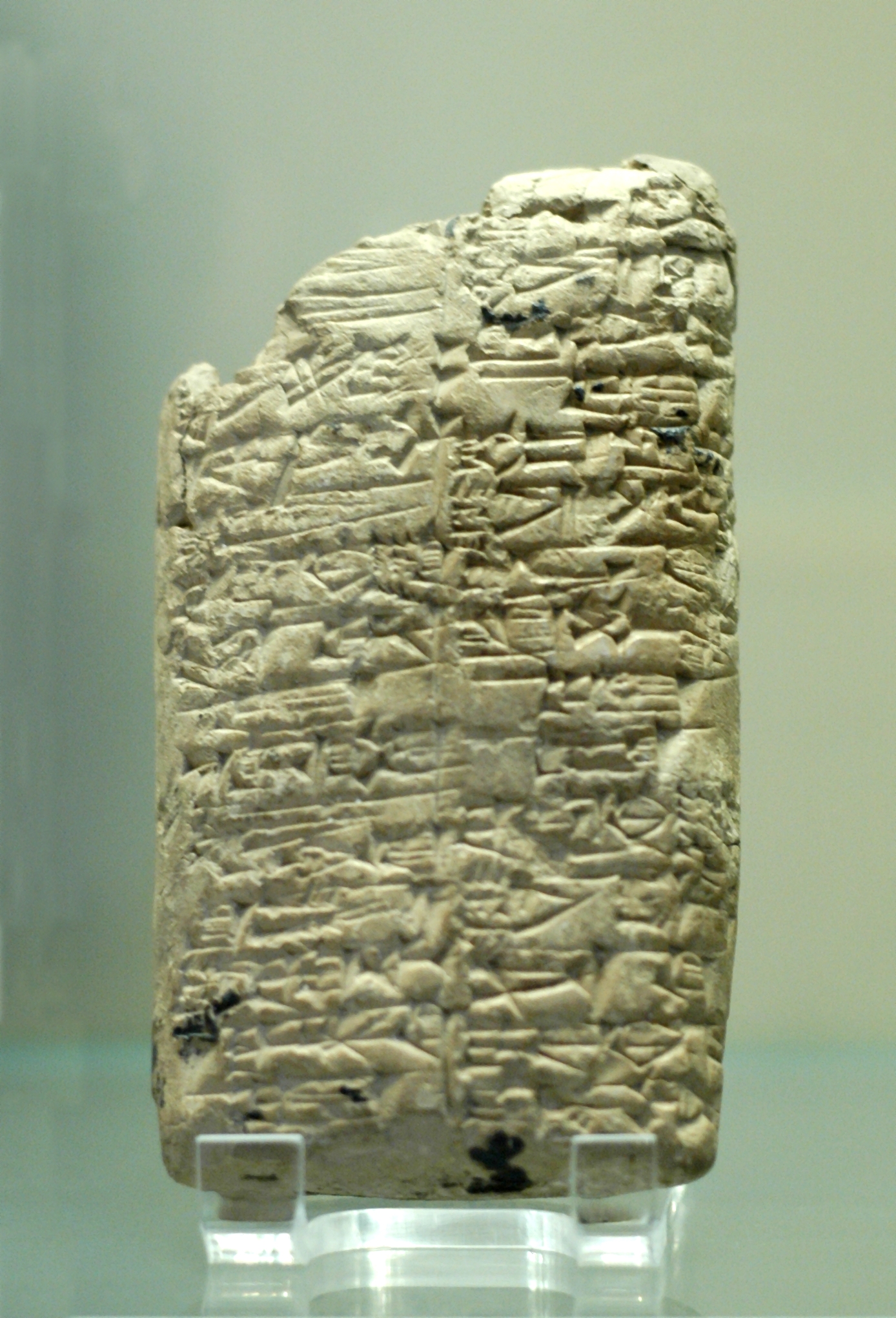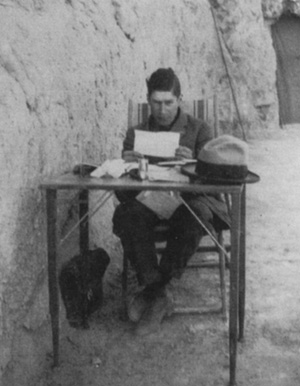|
Tell Khaiber
Tell Khaiber () is a tell, or archaeological settlement mound, in southern Mesopotamia (modern-day Iraq). It is located thirteen kilometers west of the modern city of Nasiriyah, about 19 kilometers northwest of the ancient city of Ur in Dhiq Qar Province and 25 kilometers south of the ancient city of Larsa. In 2012, the site was visited by members of the Ur Region Archaeology Project (URAP), a cooperation between the British Institute for the Study of Iraq, the University of Manchester and the Iraqi State Board for Antiquities and Heritage. They found that the site had escaped looting, and applied for an excavation permit. History Very little is known about the Sealand Dynasty. Traditionally it was thought to exist roughly between 1700 and 1400 BC and to have replaced Babylon after its fall sometime around 1550 BC. Tell Khaiber is the first Sealand site excavated. It has been dated to circa 1500 BC. Pottery shards from earlier periods including Late Uruk and Jemdet Nasr were ... [...More Info...] [...Related Items...] OR: [Wikipedia] [Google] [Baidu] |
Tell (archaeology)
In archaeology, a tell or tel (borrowed into English from ar, تَلّ, ', 'mound' or 'small hill'), is an artificial topographical feature, a species of mound consisting of the accumulated and stratified debris of a succession of consecutive settlements at the same site, the refuse of generations of people who built and inhabited them, and of natural sediment. (Very limited snippet view).Matthews (2020)Introduction and Definition/ref> Tells are most commonly associated with the ancient Near East, but they are also found elsewhere, such as Southern and parts of Central Europe, from Greece and Bulgaria to Hungary and SpainBlanco-González & Kienlin, eds (2020), 6th page of chapter 1, see map. and in North Africa. Within the Near East, they are concentrated in less arid regions, including Upper Mesopotamia, the Southern Levant, Anatolia and Iran, which had more continuous settlement. Eurasian tells date to the Neolithic,Blanco-González & Kienlin, eds (2020), 2nd page of chapter 1 ... [...More Info...] [...Related Items...] OR: [Wikipedia] [Google] [Baidu] |
Amar-Sin
Amar-Sin ( akk, : '' DAmar D Sîn'', after the Moon God Sîn", the "𒀭" being a silent honorific for "Divine"), initially misread as Bur-Sin (c. 2046-2037 BC middle chronology, or possibly ca. 1982–1973 BC short chronology) was the third ruler of the Ur III Dynasty. He succeeded his father Shulgi (c. 2030–1982 BC). His name translates to 'bull calf of the moon-god'. Reign Year-names are known for all nine years of his reign. These record campaigns conducted against Urbilum, and several other regions with obscure names: Shashrum, Shurudhum, Bitum-Rabium, Jabru, and Huhnuri. Amar-Sin is otherwise known to have campaigned against Elamite rulers such as Arwilukpi of Marhashi, and the Ur Empire under his reign extended as far as the northern provinces of Lullubi and Hamazi, with their own governors. He also ruled over Assur through the Akkadian governor Zariqum, as confirmed by his monumental inscription. Amar-Sin's reign is notable for his attempt at regenerating the ancient ... [...More Info...] [...Related Items...] OR: [Wikipedia] [Google] [Baidu] |
Archaeological Sites In Iraq
Archaeology or archeology is the scientific study of human activity through the recovery and analysis of material culture. The archaeological record consists of artifacts, architecture, biofacts or ecofacts, sites, and cultural landscapes. Archaeology can be considered both a social science and a branch of the humanities. It is usually considered an independent academic discipline, but may also be classified as part of anthropology (in North America – the four-field approach), history or geography. Archaeologists study human prehistory and history, from the development of the first stone tools at Lomekwi in East Africa 3.3 million years ago up until recent decades. Archaeology is distinct from palaeontology, which is the study of fossil remains. Archaeology is particularly important for learning about prehistoric societies, for which, by definition, there are no written records. Prehistory includes over 99% of the human past, from the Paleolithic until the advent of ... [...More Info...] [...Related Items...] OR: [Wikipedia] [Google] [Baidu] |
Cities Of The Ancient Near East
The earliest cities in history were in the ancient Near East, an area covering roughly that of the modern Middle East: its history began in the 4th millennium BC and ended, depending on the interpretation of the term, either with the conquest by the Achaemenid Empire in the 6th century BC or with that by Alexander the Great in the 4th century BC. The largest cities of the Bronze Age Near East housed several tens of thousands of people. Memphis in the Early Bronze Age, with some 30,000 inhabitants, was the largest city of the time by far. Ebla is estimated to have had a population of 40,000 inhabitants in the Intermediate Bronze age. Ur in the Middle Bronze Age is estimated to have had some 65,000 inhabitants; Babylon in the Late Bronze Age similarly had a population of some 50,000–60,000. Niniveh had some 20,000–30,000, reaching 100,000 only in the Iron Age (around 700 BC). In Akkadian and Hittite orthography, URU became a determinative sign denoting a city, or combi ... [...More Info...] [...Related Items...] OR: [Wikipedia] [Google] [Baidu] |
Sealand Dynasty
The First Sealand dynasty, (URU.KÙKIWhere ŠEŠ-ḪA of King List A and ŠEŠ-KÙ-KI of King List B are read as URU.KÙ.KI) or the 2nd Dynasty of Babylon (although it was independent of Amorite-ruled Babylon), very speculatively c. 1732–1460 BC ( short chronology), is an enigmatic series of kings attested to primarily in laconic references in the ''king lists A'' and ''B'', and as contemporaries recorded on the Assyrian ''Synchronistic king list A.117''. Initially it was named the "Dynasty of the Country of the Sea" with Sealand later becoming customary. The dynasty, which had broken free of the short lived, and by this time crumbling Old Babylonian Empire, was named for the province in the far south of Mesopotamia, a swampy region bereft of large settlements which gradually expanded southwards with the silting up of the mouths of the Tigris and Euphrates rivers (the region known as ''mat Kaldi'' " Chaldaea" in the Iron Age). Sealand pottery has been found at Girsu, Uruk, and La ... [...More Info...] [...Related Items...] OR: [Wikipedia] [Google] [Baidu] |
Akkadian Language
Akkadian (, Akkadian: )John Huehnergard & Christopher Woods, "Akkadian and Eblaite", ''The Cambridge Encyclopedia of the World's Ancient Languages''. Ed. Roger D. Woodard (2004, Cambridge) Pages 218-280 is an extinct East Semitic language that was spoken in ancient Mesopotamia ( Akkad, Assyria, Isin, Larsa and Babylonia) from the third millennium BC until its gradual replacement by Akkadian-influenced Old Aramaic among Mesopotamians by the 8th century BC. It is the earliest documented Semitic language. It used the cuneiform script, which was originally used to write the unrelated, and also extinct, Sumerian (which is a language isolate). Akkadian is named after the city of Akkad, a major centre of Mesopotamian civilization during the Akkadian Empire (c. 2334–2154 BC). The mutual influence between Sumerian and Akkadian had led scholars to describe the languages as a '' Sprachbund''. Akkadian proper names were first attested in Sumerian texts from around the mid 3rd-mi ... [...More Info...] [...Related Items...] OR: [Wikipedia] [Google] [Baidu] |
Stephanie Dalley
Stephanie Mary Dalley FSA (''née'' Page; March 1943) is a British Assyriologist and scholar of the Ancient Near East. She has retired as a teaching Fellow from the Oriental Institute, Oxford. She is known for her publications of cuneiform texts and her investigation into the Hanging Gardens of Babylon, and her proposal that it was situated in Nineveh, and constructed during Sennacherib's rule. Biography As a schoolgirl, Stephanie Page worked as a volunteer on archaeological excavations at Verulamium, Cirencester, and Bignor Villa. In 1962, she was invited by David Oates, a family friend, to an archaeological dig he was directing in Nimrud, northern Iraq. Here she was responsible for cleaning and conserving the discovered ivories. Between 1962 and 1966 she studied Assyriology at Newnham College, Cambridge, part of Cambridge University, and followed it up with a PhD from the School of Oriental and African Studies, London. In the years 1966–67, Page was awarded a Fellows ... [...More Info...] [...Related Items...] OR: [Wikipedia] [Google] [Baidu] |
Clay Tablet
In the Ancient Near East, clay tablets (Akkadian ) were used as a writing medium, especially for writing in cuneiform, throughout the Bronze Age and well into the Iron Age. Cuneiform characters were imprinted on a wet clay tablet with a stylus often made of reed (reed pen). Once written upon, many tablets were dried in the sun or air, remaining fragile. Later, these unfired clay tablets could be soaked in water and recycled into new clean tablets. Other tablets, once written, were either deliberately fired in hot kilns, or inadvertently fired when buildings were burnt down by accident or during conflict, making them hard and durable. Collections of these clay documents made up the first archives. They were at the root of the first libraries. Tens of thousands of written tablets, including many fragments, have been found in the Middle East. Surviving tablet-based documents from the Minoan/ Mycenaean civilizations, are mainly those which were used for accounting. Tablets servin ... [...More Info...] [...Related Items...] OR: [Wikipedia] [Google] [Baidu] |
Middle Bronze Age
The Bronze Age is a historic period, lasting approximately from 3300 BC to 1200 BC, characterized by the use of bronze, the presence of writing in some areas, and other early features of urban civilization. The Bronze Age is the second principal period of the three-age system proposed in 1836 by Christian Jürgensen Thomsen for classifying and studying ancient societies and history. An ancient civilization is deemed to be part of the Bronze Age because it either produced bronze by smelting its own copper and alloying it with tin, arsenic, or other metals, or traded other items for bronze from production areas elsewhere. Bronze is harder and more durable than the other metals available at the time, allowing Bronze Age civilizations to gain a technological advantage. While terrestrial iron is naturally abundant, the higher temperature required for smelting, , in addition to the greater difficulty of working with the metal, placed it out of reach of common use until the end o ... [...More Info...] [...Related Items...] OR: [Wikipedia] [Google] [Baidu] |
Euphrates River
The Euphrates () is the longest and one of the most historically important rivers of Western Asia. Tigris–Euphrates river system, Together with the Tigris, it is one of the two defining rivers of Mesopotamia ( ''the land between the rivers''). Originating in Turkey, the Euphrates flows through Syria and Iraq to join the Tigris in the Shatt al-Arab, which empties into the Persian Gulf. Etymology The Ancient Greek form ''Euphrátēs'' ( grc, Εὐφράτης, as if from Greek εὖ "good" and φράζω "I announce or declare") was adapted from Old Persian 𐎢𐎳𐎼𐎠𐎬𐎢 ''Ufrātu'', itself from Elamite language, Elamite 𒌑𒅁𒊏𒌅𒅖 ''ú-ip-ra-tu-iš''. The Elamite name is ultimately derived from a name spelt in cuneiform as 𒌓𒄒𒉣 , which read as Sumerian language, Sumerian is "Buranuna" and read as Akkadian language, Akkadian is "Purattu"; many cuneiform signs have a Sumerian pronunciation and an Akkadian pronunciation, taken from a Sumerian word a ... [...More Info...] [...Related Items...] OR: [Wikipedia] [Google] [Baidu] |
Kassite
The Kassites () were people of the ancient Near East, who controlled Babylonia after the fall of the Old Babylonian Empire c. 1531 BC and until c. 1155 BC (short chronology). They gained control of Babylonia after the Hittite sack of Babylon in 1531 BC, and established a dynasty generally assumed to have been based first in that city, after a hiatus. Later rule shifted to the new city of Dur-Kurigalzu. By the time of Babylon's fall, the Kassites had already been part of the region for a century and a half, acting sometimes with the Babylon's interests and sometimes against. There are records of Kassite and Babylonian interactions, in the context of military employment, during the reigns of Babylonian kings Samsu-iluna (1686 to 1648 BC), Abī-ešuh, and Ammī-ditāna. The origin and classification of the Kassite language, like the Sumerian language and Hurrian language, is uncertain, and, also like the two latter languages, has generated a wide array of speculation over the ... [...More Info...] [...Related Items...] OR: [Wikipedia] [Google] [Baidu] |
Early Dynastic Period (Mesopotamia)
The Early Dynastic period (abbreviated ED period or ED) is an archaeological culture in Mesopotamia (modern-day Iraq) that is generally dated to c. 2900–2350 BC and was preceded by the Uruk and Jemdet Nasr periods. It saw the development of writing and the formation of the first cities and states. The ED itself was characterized by the existence of multiple city-states: small states with a relatively simple structure that developed and solidified over time. This development ultimately led to the unification of much of Mesopotamia under the rule of Sargon, the first monarch of the Akkadian Empire. Despite this political fragmentation, the ED city-states shared a relatively homogeneous material culture. Sumerian cities such as Uruk, Ur, Lagash, Umma, and Nippur located in Lower Mesopotamia were very powerful and influential. To the north and west stretched states centered on cities such as Kish, Mari, Nagar, and Ebla. The study of Central and Lower Mesopotamia has long b ... [...More Info...] [...Related Items...] OR: [Wikipedia] [Google] [Baidu] |

.jpg)







